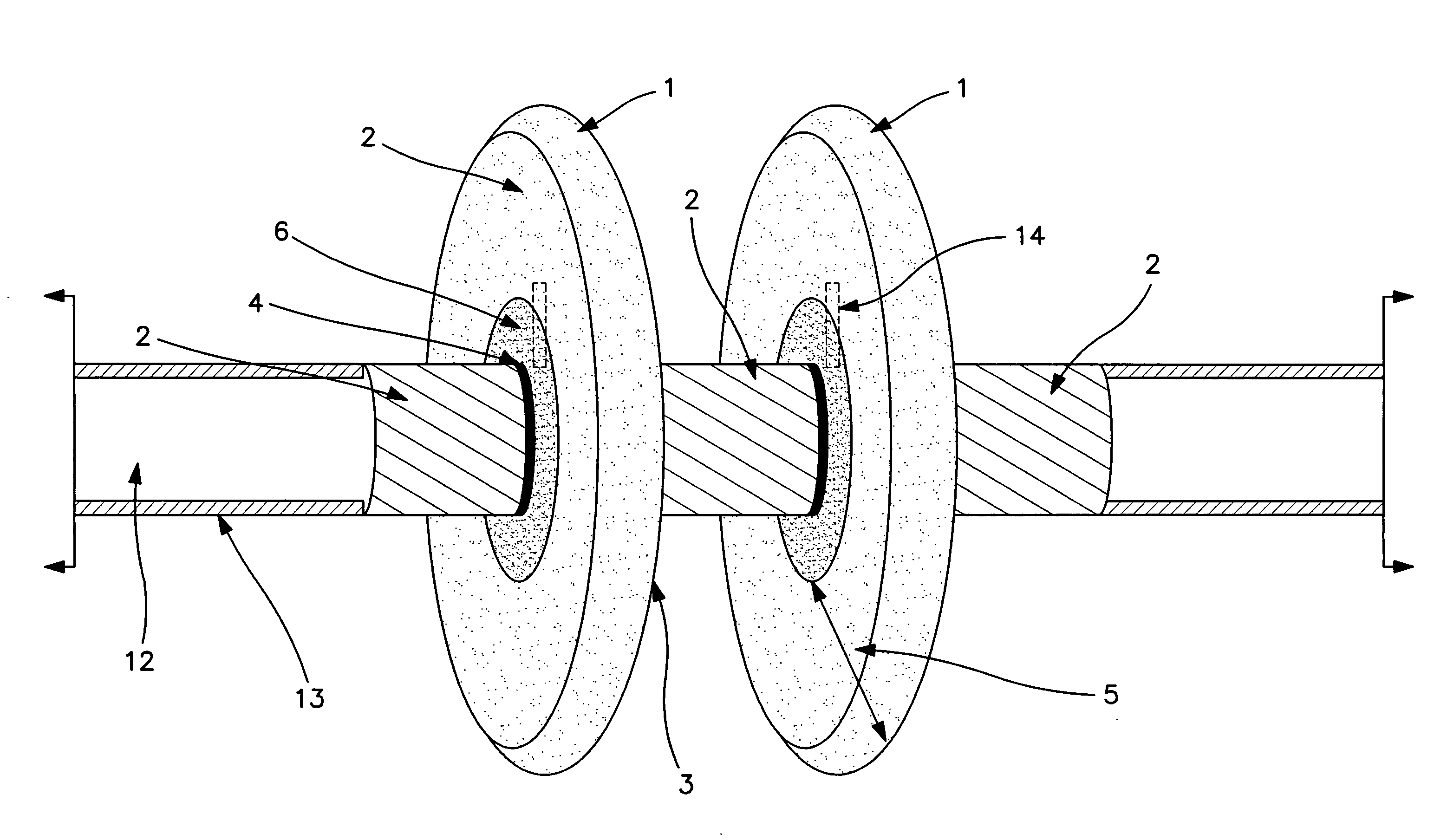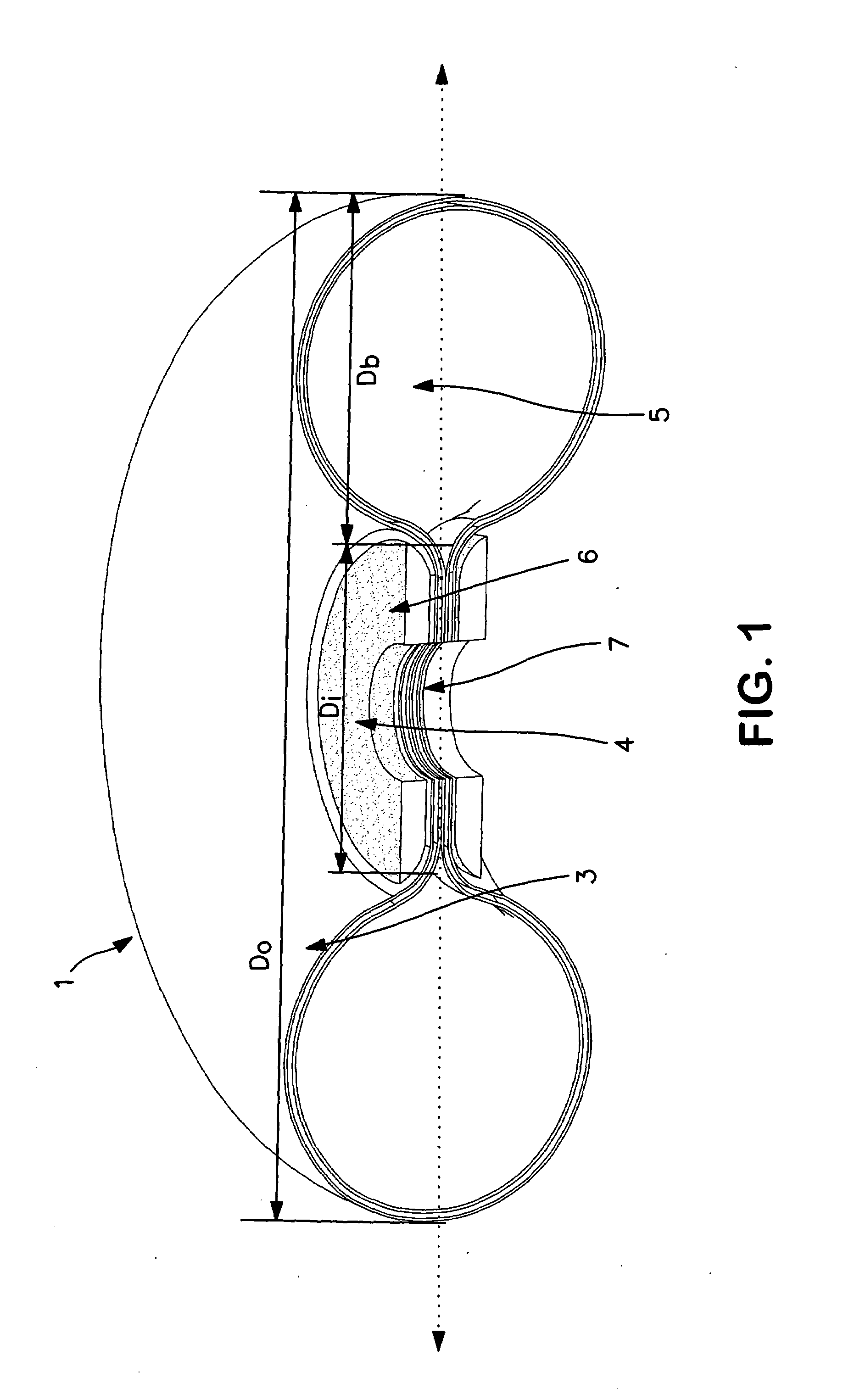Inflatable toroidal-shaped balloons
- Summary
- Abstract
- Description
- Claims
- Application Information
AI Technical Summary
Benefits of technology
Problems solved by technology
Method used
Image
Examples
example 1
Composite Film Preparation
[0050]A composite film was made by using a wire-wound rod coating process whereby a solution of Tecothane TT-1085A polyurethane and tetrahydrofuran (THF) was coated onto an ePTFE membrane. The ePTFE membrane used to make the composite film was made in accordance with general the teaching in U.S. Pat. No. 5,476,589. Specifically, the ePTFE membrane was longitudinally expanded to a ratio of 55 to 1 and transversely expanded approximately 2.25 to 1, to produce a thin strong membrane with an mass of approximately 3.5 g / m2 and a thickness of approximately 6.5 micrometers. A 3% to 8% by weight solution of Tecothane TT-1085A polyurethane in THF was coated onto the ePTFE membrane to produce a composite film with approximately equal amounts of Tecothane TT-1085A polyurethane on either side and throughout the ePTFE membrane and a total polymer weight application of approximately 40% to 60% of the total final composite film weight.
example 2
Toroidal-Shaped Balloon
[0051]A 30.5 cm long, 4.8 mm outer wall diameter stainless steel tube was cigarette wrapped with two layers of an expanded PTFE membrane and EFEP (ethylene-perfluoroethylenepropene) fluoroplastic composite with the EFEP layer facing the stainless steel tube. This ePTFE / EFEP composite film was wrapped around the tube to provide a low friction slip layer. The ePTFE membrane / EFEP composite was approximately 50 um thick. The wrapped tube was then placed into a convection oven set to 250° C. for 30 minutes. An approximately 1.5 mm diameter hole was drilled through one side of a hollow stainless steel tube, approximately centered along the length.
[0052]A first pass with 2.5 cm wide composite film as described in Example 1 was helically wrapped around the center 15 cm long section of stainless steel tube at approximately 10 degrees from the longitudinal axis of the tube. The second pass of 2.5 cm wide composite film was then wrapped in the opposite direction at the s...
example 3
Test Methods
[0058]Tensile Break Load Measurements and Matrix Tensile Strength Calculations Tensile break load was measured using an INSTRON 1122 tensile test machine equipped with flat-faced grips and a 0.445 kN load cell. The gauge length was 5.08 cm and the cross-head speed was 50.8 cm / min. The sample dimensions were 2.54 cm by 15.24 cm. For longitudinal MTS measurements, the larger dimension of the sample was oriented in the machine, also known as the down web direction. For the transverse MTS measurements, the larger dimension of the sample was oriented perpendicular to the machine direction, also known as the cross web direction. Each sample was weighed using a Mettler Toledo Scale Model AG204, then the thickness of the samples was taken using the Kafer FZ1000 / 30 thickness gauge. The samples were then tested individually on the tensile tester. Three different sections of each sample were measured. The average of the three maximum load (i.e., the peak force) measurements was use...
PUM
 Login to View More
Login to View More Abstract
Description
Claims
Application Information
 Login to View More
Login to View More - R&D
- Intellectual Property
- Life Sciences
- Materials
- Tech Scout
- Unparalleled Data Quality
- Higher Quality Content
- 60% Fewer Hallucinations
Browse by: Latest US Patents, China's latest patents, Technical Efficacy Thesaurus, Application Domain, Technology Topic, Popular Technical Reports.
© 2025 PatSnap. All rights reserved.Legal|Privacy policy|Modern Slavery Act Transparency Statement|Sitemap|About US| Contact US: help@patsnap.com



